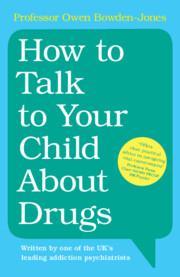Book contents
- How to Talk to Your Child About Drugs
- How to Talk to Your Child About Drugs
- Copyright page
- Contents
- Acknowledgements
- Introduction
- 1 What Are Psychoactive Drugs, Who Uses Them and Why?
- 2 Understanding Adolescence
- 3 Having the Drug Conversation with Your Child
- 4 Drugs and the Brain
- 5 How Do Drugs Cause Harm?
- 6 Types of Drugs
- 7 Rise of the Synthetics
- 8 Legal but Harmful: Prescription Medications, Tobacco, Vaping and Alcohol
- 9 Behavioural Addictions
- 10 Detecting Drug Use and What to Do about It
- 11 Treatment and Recovery
- 12 Final Thoughts
- Useful Resources
- References
- Index
10 - Detecting Drug Use and What to Do about It
Published online by Cambridge University Press: 13 February 2025
- How to Talk to Your Child About Drugs
- How to Talk to Your Child About Drugs
- Copyright page
- Contents
- Acknowledgements
- Introduction
- 1 What Are Psychoactive Drugs, Who Uses Them and Why?
- 2 Understanding Adolescence
- 3 Having the Drug Conversation with Your Child
- 4 Drugs and the Brain
- 5 How Do Drugs Cause Harm?
- 6 Types of Drugs
- 7 Rise of the Synthetics
- 8 Legal but Harmful: Prescription Medications, Tobacco, Vaping and Alcohol
- 9 Behavioural Addictions
- 10 Detecting Drug Use and What to Do about It
- 11 Treatment and Recovery
- 12 Final Thoughts
- Useful Resources
- References
- Index
Summary
Detecting drug use in adolescents can be difficult, as puberty can mimic many of the physical and emotional warning signs of drug use.
It is important to be vigilant, but don’t suggest your child is using drugs unless you have good reason to think so.
If you notice signs suggesting drug consumption, use them as a way to open a conversation about your concerns.
If your child is using psychoactive drugs
Talk to your partner, close friends or family
Act as a team
Talk to others
Consider drug testing
Seek professional help if the situation is deteriorating
Drug testing can be helpful, but it is not a treatment or a substitute for talking with your child.
Most drug tests will only detect commonly used drugs such as cocaine and cannabis. Tests for novel psychoactive substances are not routinely available. Talk to the manufacturer if you want to test for newer drugs.
No drug test is 100% accurate. Repeating the drug test reduces the risk of false results.
There are many ways to cheat a drug test. The only way to be sure of the source of a sample is to be present while it’s taken.
Advanced laboratory drug analysis is available at some larger music festival for people who choose to use them with drug checking services now expanding to other settings.
Keywords
- Type
- Chapter
- Information
- How to Talk to Your Child About Drugs , pp. 196 - 214Publisher: Cambridge University PressPrint publication year: 2025

